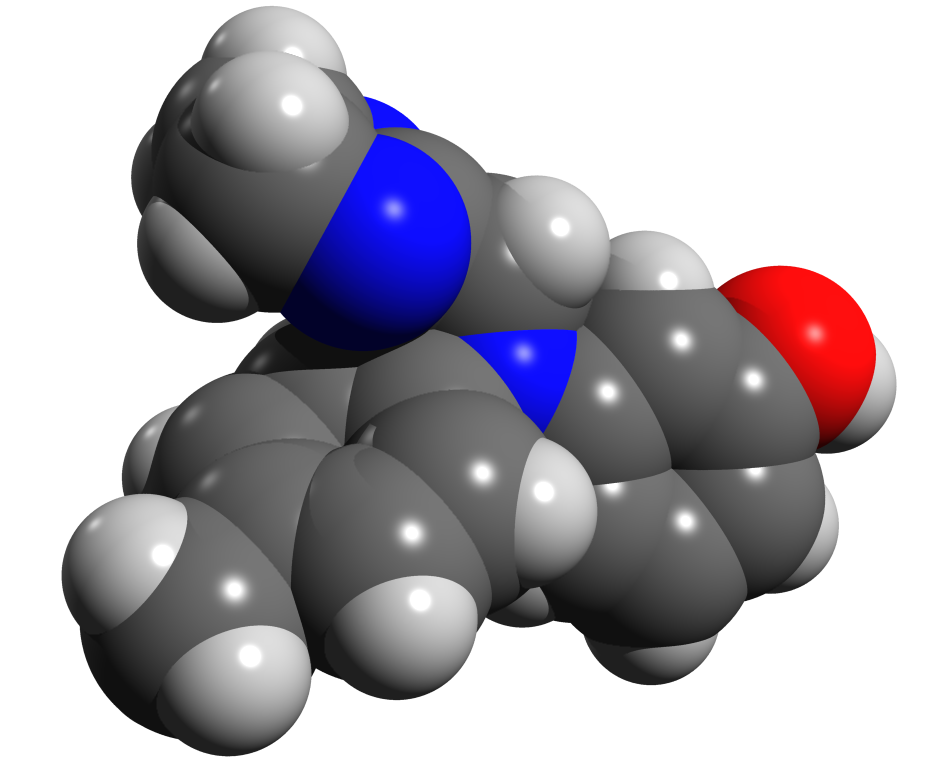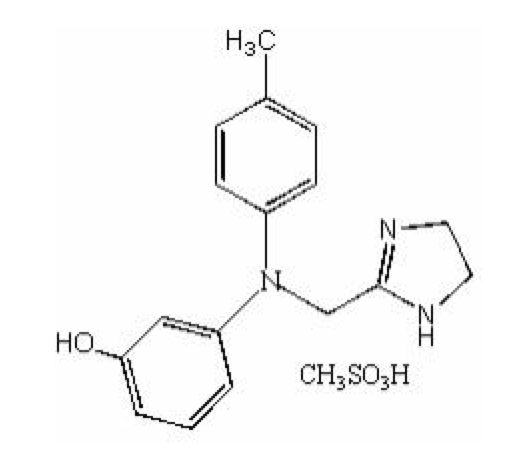Phentolamine: Difference between revisions
No edit summary |
No edit summary |
||
| Line 157: | Line 157: | ||
|useInPregnancyFDA= | |useInPregnancyFDA= | ||
* '''Pregnancy Category''' | * '''Pregnancy Category C''' | ||
:* There are no adequate and well-controlled studies in pregnant women. OraVerse should be used during pregnancy only if the potential benefit justifies the potential risk to the fetus. | |||
:* Oral administration of phentolamine to pregnant rats and mice at doses at least 24 times the recommended dose (based on a 60 kg human) resulted in slightly decreased growth and slight skeletal immaturity of the fetuses. Immaturity was manifested by increased incidence of incomplete or unossified calcaneal and phalangeal nuclei of the hind limb and of incompletely ossified sternebrae. At oral phentolamine doses at least 60 times the recommended dose (based on a 60 kg human), a slightly lower rate of implantation was found in the rat. Phentolamine did not affect embryonic or fetal development in the rabbit at oral doses at least 20 times the recommended dose (based on a 60 kg human). No teratogenic or embryotoxic effects were observed in the rat, mouse, or rabbit studies. | |||
|useInPregnancyAUS= | |useInPregnancyAUS= | ||
* '''Australian Drug Evaluation Committee (ADEC) Pregnancy Category''' | * '''Australian Drug Evaluation Committee (ADEC) Pregnancy Category''' | ||
| Line 168: | Line 169: | ||
|useInNursing= | |useInNursing= | ||
* It is not known whether OraVerse is excreted in human milk. Because many drugs are excreted in human milk, caution should be exercised when OraVerse is administered to a nursing woman. The unknown risks of limited infant exposure to phentolamine through breast milk following a single maternal dose should be weighed against the known benefits of breastfeeding. | |||
|useInPed= | |useInPed= | ||
* In clinical studies, pediatric patients between the ages of 3 and 17 years received OraVerse. The safety and effectiveness of OraVerse have been established in the age group 6-17 years. Effectiveness in pediatric patients below the age of 6 years has not been established. Use of OraVerse in patients between the ages of 6 and 17 years old is supported by evidence from adequate and well-controlled studies of OraVerse in adults, with additional adequate and well-controlled studies of OraVerse in pediatric patients ages 12-17 years old [Studies 1 (mandibular procedures) and 2 (maxillary procedures)] and ages 6-11 years old [Study 3 (mandibular and maxillary procedures)]. The safety, but not the efficacy, of OraVerse has been evaluated in pediatric patients under the age of 6 years old. Dosages in pediatric patients may need to be limited based on body weight. | |||
|useInGeri= | |useInGeri= | ||
* Of the total number of patients in clinical studies of OraVerse, 55 were 65 and over, while 21 were 75 and over. No overall differences in safety or effectiveness were observed between these patients and younger patients, and other reported clinical experience has not identified differences in responses between the elderly and younger patients, but greater sensitivity of some older individuals cannot be ruled out. | |||
|useInGender= | |useInGender= | ||
There is no FDA guidance on the use of {{PAGENAME}} with respect to specific gender populations. | There is no FDA guidance on the use of {{PAGENAME}} with respect to specific gender populations. | ||
| Line 220: | Line 219: | ||
====Signs and Symptoms==== | ====Signs and Symptoms==== | ||
* | * No deaths due to acute poisoning with phentolamine have been reported. | ||
* Overdosage with parenterally administered phentolamine is characterized chiefly by cardiovascular disturbances, such as arrhythmias, tachycardia, hypotension, and possibly shock. In addition, the following might occur: excitation, headache, sweating, pupillary contraction, visual disturbances, nausea, vomiting, diarrhea, or hypoglycemia. | |||
====Management==== | ====Management==== | ||
* | * There is no specific antidote; treatment consists of appropriate monitoring and supportive care. Substantial decreases in blood pressure or other evidence of shock-like conditions should be treated vigorously and promptly. | ||
===Chronic Overdose=== | ===Chronic Overdose=== | ||
Revision as of 15:32, 26 July 2014
Editor-In-Chief: C. Michael Gibson, M.S., M.D. [1]; Associate Editor(s)-in-Chief: Gerald Chi
Disclaimer
WikiDoc MAKES NO GUARANTEE OF VALIDITY. WikiDoc is not a professional health care provider, nor is it a suitable replacement for a licensed healthcare provider. WikiDoc is intended to be an educational tool, not a tool for any form of healthcare delivery. The educational content on WikiDoc drug pages is based upon the FDA package insert, National Library of Medicine content and practice guidelines / consensus statements. WikiDoc does not promote the administration of any medication or device that is not consistent with its labeling. Please read our full disclaimer here.
Overview
Phentolamine is a vasodilator and alpha-adrenergic blocker that is FDA approved for the {{{indicationType}}} of reversal of the soft-tissue anesthesia. Common adverse reactions include injection site pain, diarrhea, and nasal congestion.
Adult Indications and Dosage
FDA-Labeled Indications and Dosage (Adult)
Reversal of the Soft-Tissue Anesthesia
- OraVerse is indicated for reversal of the soft-tissue anesthesia, i.e., anesthesia of the lip and tongue, and the associated functional deficits resulting from an intraoral submucosal injection of a local anesthetic containing a vasoconstrictor. OraVerse is not recommended for use in children less than 6 years of age or weighing less than 15 kg (33 lbs).
- Dosing Information
- The recommended dose of OraVerse is based on the number of cartridges of local anesthetic with vasoconstrictor administered:
- OraVerse should be administered following the dental procedure using the same location(s) and technique(s) (infiltration or block injection) employed for the administration of the local anesthetic.
- Note: Do not administer OraVerse if the product is discolored or contains particulate matter.
Off-Label Use and Dosage (Adult)
Guideline-Supported Use
There is limited information regarding Off-Label Guideline-Supported Use of Phentolamine in adult patients.
Non–Guideline-Supported Use
Hypertension
- Dosing Information
- Intravenous phentolamine 5 to 20 milligrams is effective for treating hypertensive crises induced by high levels of circulating catecholamines. conditions which phentolamine may by effective for include pheochromocytoma, clonidine withdrawal, and monoamine oxidase inhibitor interactions.[1]
Sympathetically Maintained Pain
- Phentolamine (1 to 10 milligrams, increasing at 3- to 8-minute intervals up to 25 milligrams) is effective for determining if pain is sympathetically maintained.[2]
Pediatric Indications and Dosage
FDA-Labeled Indications and Dosage (Pediatric)
Reversal of the Soft-Tissue Anesthesia
- Dosing Information
- In pediatric patients weighing 15-30 kg, the maximum dose of OraVerse recommended is 1/2 cartridge (0.2 mg).
- Note: Use in pediatric patients under 6 years of age or weighing less than 15 kg (33 lbs) is not recommended. A dose of more than 1 cartridge [0.4 mg] of OraVerse has not been studied in children less than 12 years of age.
Off-Label Use and Dosage (Pediatric)
Guideline-Supported Use
There is limited information regarding Off-Label Guideline-Supported Use of Phentolamine in pediatric patients.
Non–Guideline-Supported Use
There is limited information regarding Off-Label Non–Guideline-Supported Use of Phentolamine in pediatric patients.
Contraindications
- None (phentolamine mesylate solution for submucosal use)
Warnings
- Cardiovascular Events
- Myocardial infarction, cerebrovascular spasm, and cerebrovascular occlusion have been reported to occur following the parenteral administration of phentolamine. These events usually occurred in association with marked hypotensive episodes producing shock-like states.
- Tachycardia and cardiac arrhythmias may occur with the use of phentolamine or other alpha-adrenergic blocking agents. Although such effects are uncommon after administration of OraVerse, clinicians should be alert to the signs and symptoms of these events, particularly in patients with a prior history of cardiovascular disease.
Adverse Reactions
Clinical Trials Experience
- In clinical trials, the most common adverse reaction with OraVerse that was greater than the control group was injection site pain.
- Because clinical trials are conducted under widely varying conditions, adverse reaction rates observed in the clinical trials of a drug cannot be directly compared to rates in the clinical trials of another drug and may not reflect the rates observed in practice.
- Dental patients were administered a dose of either 0.2, 0.4 or 0.8 mg of OraVerse. The majority of adverse reactions were mild and resolved within 48 hours. There were no serious adverse reactions and no discontinuations due to adverse reactions.
- Table 1 lists adverse reactions where the frequency was greater than or equal to 3% in any OraVerse dose group and was equal to or exceeded that of the control group.
- An examination of population subgroups did not reveal a differential adverse reaction incidence on the basis of age, gender, or race.
- Results from the pain assessments in Study 1 and Study 2, involving mandibular and maxillary procedures, respectively, indicated that the majority of dental patients in both OraVerse and control groups experienced no or mild oral pain, with less than 10% of patients in each group reporting moderate oral pain with a similar distribution between the OraVerse and control groups. No patient experienced severe pain in these studies.
- Adverse Reactions in Clinical Trials
- Adverse reactions reported by less than 3% but at least 2 dental patients receiving OraVerse and occurring at a greater incidence than those receiving control, included diarrhea, facial swelling, increased blood pressure/hypertension, injection site reactions, jaw pain, oral pain, paresthesia, pruritus, tenderness, upper abdominal pain and vomiting. The majority of these adverse reactions were mild and resolved within 48 hours. The few reports of paresthesia were mild and transient and resolved during the same time period.
Postmarketing Experience
- The following adverse reactions have been identified during postapproval parenteral use of phentolamine mesylate. Because these reactions are reported voluntarily from a population of uncertain size, it is not always possible to reliably estimate their frequency or establish a causal relationship to drug exposure.
- Acute and prolonged hypotensive episodes and cardiac arrhythmias have been reported with the use of phentolamine. In addition, weakness, dizziness, flushing, orthostatic hypotension, and nasal stuffiness have occurred.
Drug Interactions
- Lidocaine and Epinephrine
- When OraVerse was administered as an intraoral submucosal injection 30 minutes after injection of a local anesthetic, 2% lidocaine HCl with 1:100,000 epinephrine, the lidocaine concentration increased immediately after OraVerse intraoral injection. Lidocaine AUC and Cmax values were not affected by administration of OraVerse. OraVerse administration did not affect the PK of epinephrine.
Use in Specific Populations
Pregnancy
- Pregnancy Category C
- There are no adequate and well-controlled studies in pregnant women. OraVerse should be used during pregnancy only if the potential benefit justifies the potential risk to the fetus.
- Oral administration of phentolamine to pregnant rats and mice at doses at least 24 times the recommended dose (based on a 60 kg human) resulted in slightly decreased growth and slight skeletal immaturity of the fetuses. Immaturity was manifested by increased incidence of incomplete or unossified calcaneal and phalangeal nuclei of the hind limb and of incompletely ossified sternebrae. At oral phentolamine doses at least 60 times the recommended dose (based on a 60 kg human), a slightly lower rate of implantation was found in the rat. Phentolamine did not affect embryonic or fetal development in the rabbit at oral doses at least 20 times the recommended dose (based on a 60 kg human). No teratogenic or embryotoxic effects were observed in the rat, mouse, or rabbit studies.
- Australian Drug Evaluation Committee (ADEC) Pregnancy Category
There is no Australian Drug Evaluation Committee (ADEC) guidance on usage of Phentolamine in women who are pregnant.
Labor and Delivery
There is no FDA guidance on use of Phentolamine during labor and delivery.
Nursing Mothers
- It is not known whether OraVerse is excreted in human milk. Because many drugs are excreted in human milk, caution should be exercised when OraVerse is administered to a nursing woman. The unknown risks of limited infant exposure to phentolamine through breast milk following a single maternal dose should be weighed against the known benefits of breastfeeding.
Pediatric Use
- In clinical studies, pediatric patients between the ages of 3 and 17 years received OraVerse. The safety and effectiveness of OraVerse have been established in the age group 6-17 years. Effectiveness in pediatric patients below the age of 6 years has not been established. Use of OraVerse in patients between the ages of 6 and 17 years old is supported by evidence from adequate and well-controlled studies of OraVerse in adults, with additional adequate and well-controlled studies of OraVerse in pediatric patients ages 12-17 years old [Studies 1 (mandibular procedures) and 2 (maxillary procedures)] and ages 6-11 years old [Study 3 (mandibular and maxillary procedures)]. The safety, but not the efficacy, of OraVerse has been evaluated in pediatric patients under the age of 6 years old. Dosages in pediatric patients may need to be limited based on body weight.
Geriatic Use
- Of the total number of patients in clinical studies of OraVerse, 55 were 65 and over, while 21 were 75 and over. No overall differences in safety or effectiveness were observed between these patients and younger patients, and other reported clinical experience has not identified differences in responses between the elderly and younger patients, but greater sensitivity of some older individuals cannot be ruled out.
Gender
There is no FDA guidance on the use of Phentolamine with respect to specific gender populations.
Race
There is no FDA guidance on the use of Phentolamine with respect to specific racial populations.
Renal Impairment
There is no FDA guidance on the use of Phentolamine in patients with renal impairment.
Hepatic Impairment
There is no FDA guidance on the use of Phentolamine in patients with hepatic impairment.
Females of Reproductive Potential and Males
There is no FDA guidance on the use of Phentolamine in women of reproductive potentials and males.
Immunocompromised Patients
There is no FDA guidance one the use of Phentolamine in patients who are immunocompromised.
Administration and Monitoring
Administration
- Submucosal use
Monitoring
There is limited information regarding Monitoring of Phentolamine in the drug label.
- Description
IV Compatibility
There is limited information regarding IV Compatibility of Phentolamine in the drug label.
Overdosage
Acute Overdose
Signs and Symptoms
- No deaths due to acute poisoning with phentolamine have been reported.
- Overdosage with parenterally administered phentolamine is characterized chiefly by cardiovascular disturbances, such as arrhythmias, tachycardia, hypotension, and possibly shock. In addition, the following might occur: excitation, headache, sweating, pupillary contraction, visual disturbances, nausea, vomiting, diarrhea, or hypoglycemia.
Management
- There is no specific antidote; treatment consists of appropriate monitoring and supportive care. Substantial decreases in blood pressure or other evidence of shock-like conditions should be treated vigorously and promptly.
Chronic Overdose
There is limited information regarding Chronic Overdose of Phentolamine in the drug label.
Pharmacology
 | |
 | |
| Clinical data | |
|---|---|
| Trade names | Regitine |
| AHFS/Drugs.com | Micromedex Detailed Consumer Information |
| Pregnancy category |
|
| Routes of administration | Usually IV or IM |
| ATC code | |
| Pharmacokinetic data | |
| Metabolism | Hepatic |
| Elimination half-life | 19 minutes |
| Identifiers | |
| |
| CAS Number | |
| PubChem CID | |
| IUPHAR/BPS | |
| DrugBank | |
| ChemSpider | |
| UNII | |
| KEGG | |
| ChEBI | |
| ChEMBL | |
| E number | {{#property:P628}} |
| ECHA InfoCard | {{#property:P2566}}Lua error in Module:EditAtWikidata at line 36: attempt to index field 'wikibase' (a nil value). |
| Chemical and physical data | |
| Formula | C17H19N3O |
| Molar mass | 281.352 g/mol |
| 3D model (JSmol) | |
| |
| |
| | |
Mechanism of Action
Structure
Pharmacodynamics
There is limited information regarding Pharmacodynamics of Phentolamine in the drug label.
Pharmacokinetics
There is limited information regarding Pharmacokinetics of Phentolamine in the drug label.
Nonclinical Toxicology
There is limited information regarding Nonclinical Toxicology of Phentolamine in the drug label.
Clinical Studies
There is limited information regarding Clinical Studies of Phentolamine in the drug label.
How Supplied
Storage
There is limited information regarding Phentolamine Storage in the drug label.
Images
Drug Images
{{#ask: Page Name::Phentolamine |?Pill Name |?Drug Name |?Pill Ingred |?Pill Imprint |?Pill Dosage |?Pill Color |?Pill Shape |?Pill Size (mm) |?Pill Scoring |?NDC |?Drug Author |format=template |template=DrugPageImages |mainlabel=- |sort=Pill Name }}
Package and Label Display Panel
{{#ask: Label Page::Phentolamine |?Label Name |format=template |template=DrugLabelImages |mainlabel=- |sort=Label Page }}
Patient Counseling Information
There is limited information regarding Patient Counseling Information of Phentolamine in the drug label.
Precautions with Alcohol
- Alcohol-Phentolamine interaction has not been established. Talk to your doctor about the effects of taking alcohol with this medication.
Brand Names
- Regitine®
- Oraverse®[3]
Look-Alike Drug Names
- A® — B®[4]
Drug Shortage Status
Price
References
The contents of this FDA label are provided by the National Library of Medicine.
- ↑ Kincaid-Smith, P. (1985-04-15). "Vasodilator drugs in the treatment of hypertension". The Medical Journal of Australia. 142 (8): 450–453. ISSN 0025-729X. PMID 3884988.
- ↑ Raja, S. N. (1991-04). "Systemic alpha-adrenergic blockade with phentolamine: a diagnostic test for sympathetically maintained pain". Anesthesiology. 74 (4): 691–698. ISSN 0003-3022. PMID 1848966. Unknown parameter
|coauthors=ignored (help); Check date values in:|date=(help) - ↑ "Oraverse (phentolamine mesylate)".
- ↑ "http://www.ismp.org". External link in
|title=(help)
{{#subobject:
|Page Name=Phentolamine |Pill Name=No image.jpg |Drug Name= |Pill Ingred=|+sep=; |Pill Imprint= |Pill Dosage= |Pill Color=|+sep=; |Pill Shape= |Pill Size (mm)= |Pill Scoring= |Pill Image= |Drug Author= |NDC=
}}
{{#subobject:
|Label Page=Phentolamine |Label Name=Phentolamine11.png
}}
{{#subobject:
|Label Page=Phentolamine |Label Name=Phentolamine11.png
}}
- Pages with script errors
- Pages with citations using unsupported parameters
- CS1 errors: dates
- CS1 errors: external links
- Template:drugs.com link with non-standard subpage
- Articles with changed EBI identifier
- E number from Wikidata
- ECHA InfoCard ID from Wikidata
- Chemical articles with unknown parameter in Infobox drug
- Drugs with no legal status
- Drugboxes which contain changes to verified fields
- Cardiovascular Drugs
- Drug
- Vasodilators
- Imidazolines
- Alpha blockers


